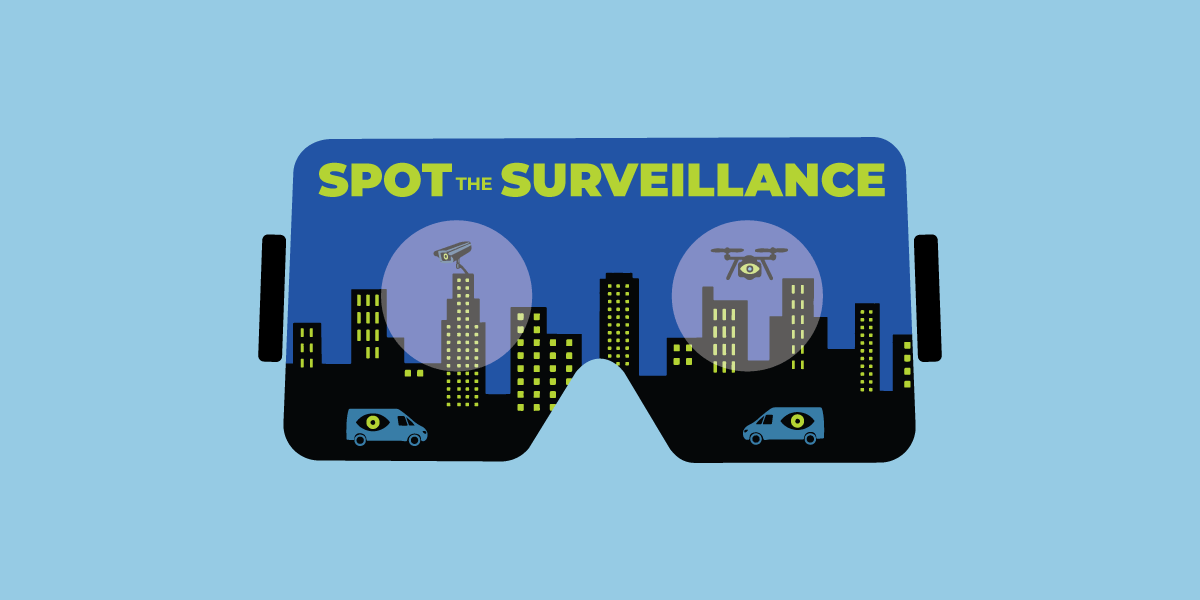This post was written by Summer 2020 Intern Jessica Romo, a student at the Reynolds School of Journalism at University of Nevada, Reno.
As law enforcement and government surveillance technology continues to become more and more advanced, it has also become harder for everyday people to avoid. Law enforcement agencies all over the United States are using body-worn cameras, automated license plate readers, drones, and much more—all of which threat people's right to privacy. But it's often difficult for people to even become aware of what technology is being used where they live.
The Electronic Frontier Foundation has three interactive tools that help you learn about the new technologies being deployed around the United States and how they impact you: the Atlas of Surveillance, Spot the Surveillance, and Who Has Your Face?
The Atlas of Surveillance
https://atlasofsurveillance.org
The Atlas of Surveillance is a database and map that will help you understand the magnitude of surveillance at the national level, as well as what kind of technology is used locally where you live.
Developed in partnership with the University of Nevada, Reno's Reynolds School of Journalism, the Atlas of Surveillance is a dataset with more than 5,500 points of information on technology surveillance used by law enforcement agencies across the United States. Journalism students and EFF volunteers gathered online research, such as news articles and government records, on 10 common surveillance technologies and two different types of surveillance command centers.
By clicking any point on the map, you will get the name of an agency and a description of the technology. If you toggle the interactive legend, you can see how each technology is spreading across the country. You can also search a simple-to-use text version of the database of all the research, including links to news articles or documents that confirm the existence of the technology in that region.
Who Has Your Face?
https://whohasyourface.org/
Half of all adults in the United States likely have their image in a law enforcement facial recognition database, according to a 2016 report from the Center on Privacy & Technology at Georgetown Law. Today, that number is probably higher. But what about your face?
Face recognition is a form of biometric surveillance that uses software to automatically identify or track someone based on their physical characteristics. People are subjected to face recognition in hundreds of cities around the country. Government has a number of uses for the technology, from screening passengers at airports to identifying protesters caught on camera.
Who Has Your Face? is a short quiz that allows a user to see which government agencies can access their official photographs (such as a driver's license or a mugshot) and whether investigators can apply face recognition technology to those photos.
The site doesn't collect personal information, but it does ask five basic questions, such as whether you have a driver's license and if so, what state issued it. Based on your choice, the system will automatically generate a list of agencies that could potentially access your images.
It also includes a resource page listing what each state’s DMV and other agencies can access.
Spot the Surveillance
https://eff.org/spot
If you drove past an automated license plate reader, would you know what it looks like? Ever look closely at the electronic devices carried by police officers? Most of the time, people might not even notice when they've walked into the frame of surveillance technology.
Spot the Surveillance is a virtual reality experience where you will learn how to identify surveillance technology that local law enforcement agencies use.
The experience takes place in a San Francisco neighborhood, where a resident is having an interaction with two police officers. You'll look in every direction to find seven technologies being deployed. After you find each technology, you’ll learn more about how it operates and how it’s used by police. Afterwards, you can try your new skills to identify these technologies in real life in your hometown.
Spot the Surveillance works with most VR headsets, but is also available to use on a regular web browser. There’s also a Spanish version.
Get To Know The Surveillance That’s Getting To Know You
EFF has fought back against surveillance for decades, but we need your help. What other interactive tools would you like to see? Let us know on social media or by emailing info@eff.org, so we can continue to help you protect your privacy.

















